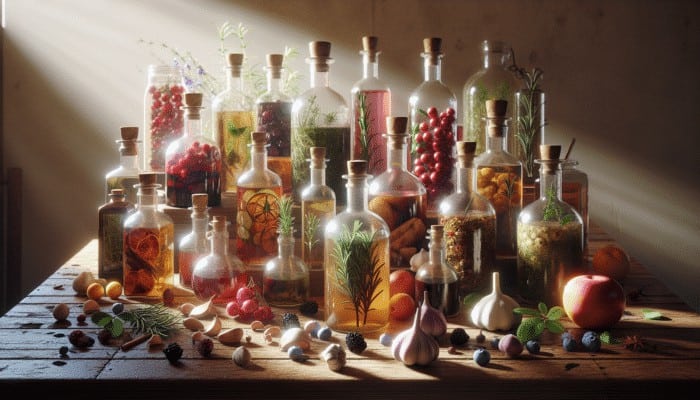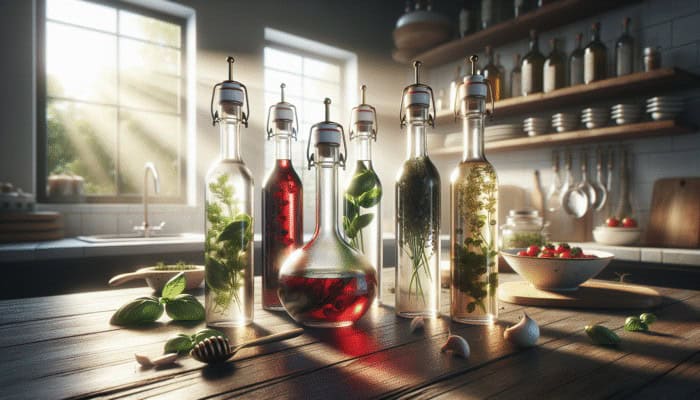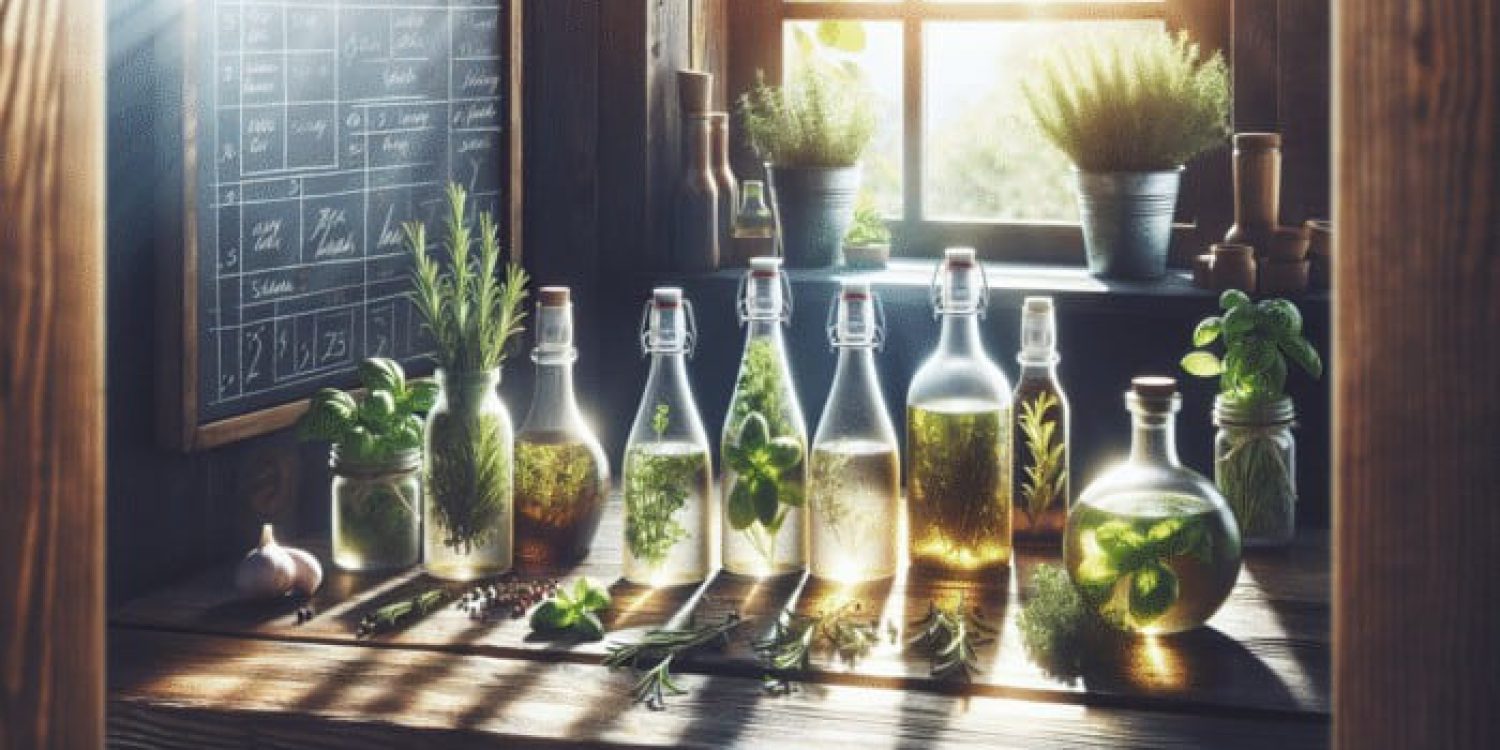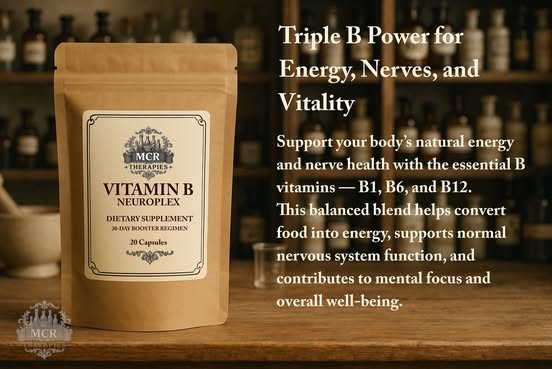Choosing the Perfect Herbs for Your Vinegar Infusions
Popular Herbs Grown in the UK for Infusions

Herbs are revered in the culinary world, and the UK is home to an impressive array of flavourful choices that are ideal for vinegar infusions. Common garden herbs such as rosemary, thyme, and mint flourish in British gardens and lend aromatic richness to vinegars. The robust, pine-like aroma of rosemary pairs exceptionally well with cider vinegar, creating a tangy yet fragrant infusion that can elevate everything from salad dressings to roasted vegetables. In contrast, thyme brings a more understated herbal flavour that perfectly balances the acidity of malt vinegar, making it a versatile condiment for marinades and drizzles alike.
Mint, with its invigorating qualities, is especially popular for summer infusions. When combined with white wine vinegar, it results in a refreshing and crisp infusion that can enhance both culinary dishes and cocktails. Additionally, herbs like chives and basil can be used to craft distinctive blends that resonate with the British palate, transforming classic recipes into contemporary culinary delights. When selecting herbs, it's essential to consider both their flavour profiles and the intended application of the vinegar to ensure a harmonious pairing.
Understanding Seasonal Availability of Herbs
The success of herbal vinegar infusions is intricately linked to the seasons, making it vital to be aware of the optimal times for harvesting herbs in the UK. Spring is the season that heralds the arrival of fresh herbs, with rosemary and thyme reaching their flavour peak from late spring to early summer. During this time, these herbs exhibit heightened fragrance, making them ideal candidates for infusion. By summer, vibrant herbs such as mint and basil thrive, offering an abundance of flavours that can be captured in vinegar.
As autumn approaches, there is another chance to forage for robust herbs that withstand cooler temperatures. By late autumn, herbs like sage and parsley remain viable, allowing for inventive infusions as the year winds down. A thorough understanding of seasonal cycles not only enhances flavour but also promotes a sustainable approach to growing and foraging for herbs. Aligning your infusion practices with the natural availability of herbs allows you to craft vinegars that genuinely reflect the essence of each season in the UK.
Creative Herb Combinations for Unique Infusions
Exploring herb combinations unlocks a vast array of flavour possibilities for vinegar infusions, particularly within the UK's culinary scene. Traditional pairings like rosemary and garlic produce a fragrant infusion that beautifully complements roasted meats and vegetables. Alternatively, a blend of thyme and lemon zest introduces a zesty twist, perfect for dressings or marinades.
For those with a more adventurous palate, consider mixing herbs with a hint of fruit or spice. For example, combining mint with strawberries can yield a refreshing vinegar, ideal for summer salads or desserts. Additionally, experimenting with herbs like dill and coriander can add a distinctive flair, particularly in dressings for fish or Mediterranean-inspired dishes. The creative opportunities are limitless, and by exploring various herb combinations, you can craft bespoke infusions that reflect your culinary preferences and creativity.
Exploring Various Types of Vinegar for Infusions

The Benefits of Cider Vinegar for Infusions
Cider vinegar has established itself as a staple in UK kitchens, celebrated not only for its health benefits but also for its compatibility with a wide range of herbs during infusions. The natural sweetness inherent in apple cider vinegar harmonises beautifully with various herbs, resulting in vibrant herbal infusions. This unique characteristic makes cider vinegar an excellent choice for those looking to create lively and flavourful herbal blends. The natural acidity of cider vinegar ensures that the bold flavours of herbs such as rosemary and thyme remain prominent while balancing sweetness with a refreshing tang.
Moreover, cider vinegar is readily available in local supermarkets and farmer's markets, making it accessible for home cooks. Its versatility extends beyond herbal infusions; it can also be incorporated into dressings, marinades, and even health tonics, further enhancing its appeal. Crafting a herbal vinegar infusion using cider vinegar not only delivers a delightful taste experience but also fosters a connection to local agricultural practices, as numerous apple orchards dot the UK landscape.
The Rich Flavour of Malt Vinegar for Infusions
Renowned for its bold and distinctive flavour, malt vinegar is another beloved ingredient in UK kitchens, particularly in traditional dishes such as fish and chips. This vinegar, made from barley, adds a rich, malty undertone to herbal infusions, transforming ordinary dishes into extraordinary culinary experiences. When infused with herbs like thyme or bay leaves, malt vinegar develops a complex flavour profile, making it perfect for drizzling over hearty meals or incorporating into marinades.
Malt vinegar is particularly suited for creating infusions with traditional British herbs, embracing the essence of home-cooked meals. Its deep colour and robust flavour also render it an appealing option for pickling, allowing the infusion to serve dual purposes: a vibrant accompaniment to dishes and a means of preserving seasonal produce. By harnessing the unique characteristics of malt vinegar, home cooks can explore a myriad of flavour combinations that resonate deeply with British cuisine.
The Elegance of Wine Vinegar for Infusions

Wine vinegar, particularly in red and white varieties, offers a sophisticated option for herbal infusions, elevating the final product to new culinary heights. The acidity of wine vinegar pairs remarkably well with herbs, resulting in balanced infusions that enhance salads, sauces, and even cocktails. For example, blending white wine vinegar with herbs like basil or chervil creates a bright, fresh infusion that is perfect for summer salads or delicate seafood dishes.
Conversely, red wine vinegar marries beautifully with heartier herbs such as rosemary and oregano, imparting a robust quality to marinades and dressings. The use of wine vinegar in infusions underscores the sophistication of British culinary practices, where the fusion of flavours can result in truly exceptional dishes. Mastering the infusion techniques with wine vinegar can unlock a world of gourmet cooking possibilities right in your own kitchen.
Creating Luxurious Infusions with Balsamic Vinegar
Balsamic vinegar, with its rich sweetness and sophisticated flavour, holds a cherished position in the realm of herbal vinegar infusions. Often associated with fine dining, it provides a sumptuous base for infusions, allowing herbs to shine without overshadowing their delicate notes. The complexity of balsamic vinegar makes it an ideal partner for herbs like sage or rosemary, yielding a beautifully layered infusion that can elevate simple dishes into extraordinary culinary experiences.
Integrating balsamic vinegar into herbal infusions also invites creativity and exploration. Infusing balsamic with herbs and fruits, such as figs or blackberries, can produce decadent results that are perfect for drizzling over cheeses or roasted meats. The versatility of balsamic vinegar ensures its enduring popularity in kitchens across the UK, allowing cooks to experiment with diverse flavour combinations that suit various occasions.
Mastering Infusion Techniques for Optimal Flavour
Utilising the Cold Infusion Method for Herbal Extracts
The cold infusion method is a widely embraced technique in the UK, allowing for the pure essence of herbs to be captured in vinegar while preserving their delicate flavours. This approach involves submerging fresh herbs in vinegar and allowing them to steep without the application of heat, typically for several weeks. Key to a successful cold infusion is the selection of high-quality herbs and a suitable vinegar, ensuring that the final product achieves the desired flavour profile.
When employing the cold infusion method, it is crucial to choose herbs that maintain their flavour over time. For instance, robust herbs like rosemary and thyme are ideal candidates, as they can withstand prolonged steeping. A common practice involves placing the herbs directly in a clean glass jar filled with vinegar, sealing it tightly, and storing it in a cool, dark location. Regularly shaking the jar aids in ensuring that the flavours meld beautifully, resulting in an infusion that captures the vibrant character of the selected herbs.
One significant advantage of the cold infusion method is its simplicity and minimal energy consumption, making it an environmentally friendly approach to flavouring vinegar. Additionally, this technique is particularly suited for those eager to experiment with various herb combinations, empowering home cooks to develop unique flavours tailored to their culinary preferences. The resulting herbal vinegar can be utilised in dressings, marinades, or as a finishing touch, showcasing the depth and complexity achieved through this method.
Accelerating Flavour with the Warm Infusion Method
For those seeking a quicker path to flavourful herbal vinegar, the warm infusion method offers an effective solution. By gently heating the vinegar alongside the herbs, this technique expedites the extraction of flavours, yielding a vibrant infusion within hours rather than weeks. However, it is important to strike the right balance when applying heat, as excessive temperatures can compromise the subtle nuances of certain herbs.
To use the warm infusion method, start by heating your chosen vinegar in a saucepan until it reaches a gentle simmer. Once heated, add the herbs, ensuring they are fully submerged. Maintaining a low temperature allows the flavours to meld without cooking the herbs, which could result in bitterness. After simmering for a brief period, remove the mixture from heat and allow it to cool before straining out the herbs. The result is a lively herbal vinegar that retains the freshness of the herbs while delivering a robust flavour.
This method is particularly advantageous for those pressed for time yet keen to create unique blends. By experimenting with different herbs and vinegar types, home cooks can craft an impressive array of infused vinegars in a fraction of the time required for cold infusions. The resulting warm-infused vinegars can be employed in a variety of dishes, adding a burst of flavour that elevates everyday meals.
Eco-Friendly Solar Infusion Method for Herbal Vinegars
Harnessing the sun's energy, the solar infusion method provides an eco-friendly and visually appealing approach to creating herbal vinegar infusions. This technique involves placing herbs and vinegar in a clear glass jar and allowing the sun's rays to gently warm the mixture, gradually extracting the flavours over time. The solar infusion method not only offers a delightful sensory experience but also fosters a connection to nature and the environment.
To begin, fill a glass jar with your chosen vinegar and add fresh herbs, ensuring they are adequately submerged. Seal the jar tightly and place it in a sunny location, permitting the sun's warmth to work its magic over several days or weeks. The gentle heating accelerates the infusion process without compromising the herbs' character, resulting in a beautifully flavoured herbal vinegar. It's important to monitor the infusion periodically, gently shaking the jar to ensure even extraction.
One unique aspect of the solar infusion method is its sustainability, as it relies solely on natural sunlight rather than energy-intensive heating processes. This aligns with the growing interest in eco-friendly cooking practices among UK consumers. The final product captures not only the flavours of the chosen herbs but also the essence of the season, making it a wonderful conversation starter in your culinary creations. As you explore solar infusions, you can experiment with various herb combinations, breathing new life into your cooking repertoire.
Determining Infusion Duration for Optimal Results
Quick Short-Term Infusions for Immediate Use
Short-term infusions present a practical choice for those desiring quick results without sacrificing flavour. Typically steeping for a period of one to two days, these infusions allow the vibrant characteristics of the herbs to impart their essence into the vinegar rapidly. This method is particularly popular among home cooks looking to create swift dressings or marinades that can elevate meals without extensive preparation.
In the UK, short-term infusions work exceptionally well with herbs that possess a strong flavour profile yet may lose potency over time. Herbs like mint and chives are well-suited for this method, as their bright flavours can infuse vinegar quickly and effectively. To perform a short-term infusion, simply combine your selected herbs with vinegar in a clean glass jar, seal it tightly, and let it sit at room temperature for a couple of days. Regularly shaking the jar facilitates the circulation of flavours, ensuring an even infusion.
Once the infusion period is complete, strain out the herbs, and your vibrant herbal vinegar is ready for use. This method not only saves time but also encourages experimentation with various flavour combinations, enabling home cooks to adapt to seasonal herbs or personal tastes. The resulting infused vinegar can be employed in a myriad of ways, from salad dressings to marinades, imparting a burst of freshness to everyday meals.
Enjoying the Depth of Medium-Term Infusions
Medium-term infusions, which typically last from one to four weeks, strike the perfect balance between flavour depth and convenience. This duration allows for a thorough extraction of the herbs' essence, resulting in a well-rounded vinegar that boasts complexity and richness. This method is particularly advantageous for herbs that require more time to fully release their flavours, such as thyme and oregano.
When using the medium-term infusion method, begin by selecting your preferred herbs and placing them in a clean glass jar. Pour your chosen vinegar over the herbs, ensuring they are entirely submerged, and seal the jar tightly. Store it in a dark, cool location, allowing the flavours to meld over several weeks. Shaking the jar occasionally promotes the infusion process, enhancing the development of flavour.
The charm of medium-term infusions lies in their versatility. Home cooks have the opportunity to experiment with diverse herb combinations and vinegar types, customising their infusions to suit specific recipes or occasions. Once the infusion period is complete, strain out the herbs, and the resulting herbal vinegar can be utilised in dressings, marinades, or as a flavour enhancer in various dishes. This method encourages a deeper exploration of flavours while remaining manageable for those with busy schedules.
Crafting Complex Flavours with Long-Term Infusions
Long-term infusions are a cherished technique among culinary enthusiasts, allowing for the development of deeply flavoured herbal vinegars over extended periods. Typically spanning from one to several months, this method is ideal for those wishing to create complex infusions that evolve in flavour and character. Herbs with robust profiles, such as sage and rosemary, benefit from this extended steeping time, resulting in a rich and nuanced final product.
To initiate a long-term infusion, choose your herbs and combine them with vinegar in a sterilised glass jar, ensuring that the herbs are fully submerged. Seal the jar tightly and store it in a cool, dark place, allowing the flavours to develop slowly. Throughout the infusion period, shaking the jar occasionally encourages the melding of flavours and enhances the overall infusion process.
The beauty of long-term infusions lies in their ability to capture seasonal essence, reflecting the flavours of the herbs at their peak while providing a unique depth that shorter infusions may not achieve. Home cooks often find joy in the anticipation of their creations, as the infusion matures over time, revealing new layers of flavour. Once ready, the resulting herbal vinegar can be used in a variety of dishes, showcasing the sophisticated taste profile achieved through patience and care.
Continuous Infusions for Ongoing Flavour Development
The concept of continuous infusions is gaining popularity among culinary aficionados, especially for those keen to maintain a steady supply of herb-infused vinegar. This method involves using a portion of the infused vinegar while replenishing the jar with fresh vinegar and herbs, allowing for an ongoing cycle of flavour development. This technique not only ensures a constant supply but also allows the flavours to evolve over time, resulting in a unique taste experience.
To create a continuous infusion, start by preparing a large jar filled with herbs and vinegar, allowing the mixture to infuse for a few weeks until it reaches the desired flavour. Once the infusion is established, use a portion of the vinegar for cooking or dressings, and replenish the jar with fresh vinegar and additional herbs. This process helps maintain the infusion's character while continuously enhancing it with new layers of flavour.
Continuous infusions are particularly appealing for home cooks who enjoy experimenting with diverse flavour profiles or wish to utilise seasonal herbs effectively. This method promotes a sustainable approach to cooking, allowing for a versatile and adaptable condiment that can evolve with personal tastes and seasonal ingredients. The resulting herbal vinegar can be employed in a variety of culinary applications, showcasing the creativity and ingenuity of ongoing infusion practices.
Proper Storage Techniques for Infused Vinegar
Choosing Glass Containers for Infused Vinegar
When it comes to storing herbal vinegar infusions, glass containers are the preferred choice for many within the UK culinary community. Glass is a non-reactive material, ensuring that the delicate flavours of infused vinegars are preserved without interference from the container itself. Utilizing clean, sterilised glass jars or bottles provides longevity and freshness, creating an ideal environment for the infused vinegar to mature while maintaining its vibrant character.
Selecting the appropriate glass container is crucial; opt for dark or opaque glass bottles whenever possible, as these protect the infused vinegar from light exposure, which can degrade quality over time. Additionally, ensure that the containers have airtight seals to prevent contamination and maintain flavour integrity. Properly stored herbal vinegar can last for several months, depending on the herbs used and the infusion method applied.
Incorporating glass containers into your herbal vinegar storage not only enhances the aesthetic appeal of your pantry but also reflects a commitment to quality. By keeping your infused vinegars in glass, you preserve vibrant colours and flavours, making them an enticing addition to your culinary creations. Furthermore, glass containers are recyclable, aligning with sustainable practices embraced by many cooks in the UK.
Optimal Dark Storage Conditions for Infused Vinegar
In the quest for optimal storage conditions, keeping infused vinegars in a dark environment is of utmost importance. Light exposure can diminish the flavours and colours of herbal infusions, compromising their quality and potency. By storing your infused vinegar in a dark cupboard or pantry, you can significantly prolong its shelf life while retaining the integrity of the flavours.
Temperature also plays a crucial role in storage; ideally, infused vinegars should be kept at a consistent, cool temperature away from direct sunlight. This approach not only protects the flavours but also minimises the risk of spoilage and oxidation, ensuring that each batch of herbal vinegar remains vibrant and flavourful. When organising your storage area, consider using labelled boxes or containers to keep your infused vinegars tidy and easily accessible.
Maintaining dark storage conditions not only helps preserve the quality of your infused vinegars but also reflects a mindful approach to cooking and food preservation. By prioritising proper storage techniques, you can enjoy the fruits of your labour for extended periods, enhancing your culinary adventures with well-preserved flavours and aromas.
Refrigeration: Extending the Shelf Life of Infused Vinegar
Refrigeration is a widely adopted practice in the UK for prolonging the life of infused vinegars, particularly those crafted with fresh herbs. Keeping infused vinegars in the fridge serves to slow down the fermentation process and inhibit the growth of unwanted bacteria, ensuring that the flavours remain pure and delightful. This is especially important for herbal vinegars containing delicate herbs or those infused with fruits, as these tend to have shorter shelf lives.
When refrigerating your herbal infusions, ensure they are stored in airtight glass containers to prevent flavours from mingling with other fridge items. This practice not only extends shelf life but also preserves the vibrant taste of the infused vinegar, allowing you to enjoy its full potential. As a general guideline, herbal vinegars stored in the refrigerator can last anywhere from several months to a year, depending on the ingredients and infusion method.
The convenience of refrigeration aligns well with the busy lifestyles of many UK home cooks, providing an accessible way to keep infused vinegars readily available for everyday use. Additionally, the refreshing qualities of chilled herb-infused vinegars can enhance salads, marinades, and sauces during warmer months, making refrigeration a practical choice for both flavour preservation and culinary enjoyment.
The Importance of Labelling and Dating Infused Vinegar
Implementing a labelling and dating system for your infused vinegars is essential for ensuring freshness and maintaining organisation in your kitchen. By clearly marking the date of preparation and the ingredients used on each jar or bottle, you can easily track the age of your infusions and determine when they should be used or discarded. This straightforward yet effective method helps prevent confusion regarding the quality of your infused vinegars.
Labelling also facilitates easy identification of different flavours, simplifying the selection process for specific culinary applications. When you have multiple infusions on hand, a well-organised system aids in the creative process, allowing you to explore various flavour nuances at a glance. Consider using waterproof labels or permanent markers to ensure that the information remains legible over time.
In the UK, where seasonal ingredients and flavours are celebrated, maintaining an organised collection of infused vinegars can inspire creativity in the kitchen. By keeping track of your infusions, you not only ensure their quality but also encourage a more intentional approach to cooking, elevating your culinary experiences to new heights.
Key Considerations for Shelf Life of Infused Vinegar
Understanding the factors affecting the shelf life of infused vinegar is crucial for home cooks aiming to maximise their culinary creations. Various elements, including the type of herbs used, the infusion method, and storage conditions, can influence how long your herbal vinegars remain fresh and potent. Generally, properly prepared and stored infused vinegars can last several months to a year, depending on these factors.
Herbs with high moisture content, such as basil or mint, may result in shorter shelf lives, while drier herbs like thyme or rosemary tend to yield more stable infusions. Furthermore, using vinegar with a higher acidity level, like cider or wine vinegar, can help extend the shelf life of your creations. Storing infused vinegars in dark, cool conditions and avoiding moisture or contaminants are vital practices to ensure longevity.
Regularly checking your infused vinegar for changes in colour, aroma, or flavour is an excellent practice to maintain quality. This proactive approach not only enhances your culinary experiences but also encourages a mindful relationship with food. By understanding the intricacies of shelf life, you can savour the fruits of your labour and create herbal vinegars that truly shine in your culinary repertoire.
Innovative Uses for Infused Vinegar in Cooking
Versatile Culinary Applications of Infused Vinegar
Herbal vinegars offer a myriad of culinary applications, enhancing dishes and elevating flavours across the board. In UK cuisine, infused vinegars are celebrated for their versatility, serving as a key ingredient in salad dressings, marinades, and sauces. For example, a rosemary-infused cider vinegar can add depth and dimension to a simple vinaigrette, transforming salads into gourmet experiences.
Incorporating infused vinegars into marinades is another excellent method to impart flavour to meats and vegetables. The acidity of the vinegar tenderises proteins while infusing unique herbal notes, making everyday meals feel special. As a delightful finishing touch, drizzling infused vinegar over roasted vegetables or grilled meats adds a burst of flavour that can elevate any dish.
The creative possibilities of infused vinegars extend into the realm of beverages as well. From crafting sophisticated cocktails to enhancing homemade sodas, the inclusion of herbal vinegars can introduce an unexpected twist. Experimenting with various flavour combinations allows home cooks to explore new dimensions of taste, making infused vinegars an indispensable component of modern culinary practices in the UK.
Potential Health Benefits of Herbal Vinegar
Beyond their culinary applications, herbal vinegars are frequently lauded for their potential health benefits, making them increasingly popular within the UK wellness community. Many of the herbs used in infusions possess medicinal properties that can support overall health. For instance, rosemary is renowned for its antioxidant properties, while thyme is celebrated for its antibacterial qualities, providing a wholesome addition to your diet.
Incorporating herbal vinegars into your meals not only enhances flavour but may also aid digestion, thanks to the acetic acid present in vinegar, which is known to promote gut health. Furthermore, certain infused vinegars have been linked to stabilising blood sugar levels, making them a beneficial choice for individuals seeking to manage their sugar intake. As health-conscious consumers increasingly seek out natural remedies, the appeal of herbal vinegars continues to rise.
It's essential to approach the health benefits of herbal vinegars with an informed perspective, recognising their role as a complementary addition to a balanced diet rather than a miraculous cure. By integrating these infused delights into your meals, you can enjoy rich flavours while potentially benefiting from the wellness advantages they offer.
Preserving Foods with Infused Vinegar Techniques
Using infused vinegars for food preservation is a time-honoured tradition in the UK, enabling home cooks to maximise the use of seasonal ingredients. The high acidity of vinegar acts as a natural preservative, inhibiting the growth of harmful bacteria and extending the shelf life of various foods. Traditional pickling techniques often incorporate infused vinegars, creating delightful preserves that reflect local flavours.
To utilise infused vinegars for preservation, consider pickling vegetables or fruits. By immersing items such as cucumbers, onions, or even fruits in herbal vinegar, you create bold, exciting flavours that can enhance dishes throughout the year. The infusion process not only preserves the ingredients but also imparts a unique taste that elevates charcuterie boards, sandwiches, and salads.
Incorporating preservation techniques into your culinary repertoire encourages creativity and resourcefulness in the kitchen. By harnessing the power of herbal vinegars, UK home cooks can celebrate the bounty of seasonal produce while ensuring these flavours are savoured long after the harvest.
Simple DIY Infusion Recipes for Home Cooks
Crafting your own infused vinegar at home is an accessible and rewarding venture, allowing you to explore your creativity using UK-sourced ingredients. Start with a straightforward base recipe: select your preferred herbs, such as basil or rosemary, and combine them with your chosen vinegar—cider, malt, or wine vinegar works beautifully.
Begin by thoroughly washing the herbs and placing them in a clean glass jar. Pour the vinegar over the herbs until they are completely submerged, ensuring no air bubbles remain. Seal the jar tightly and allow the mixture to infuse for a specified duration, depending on your preferred infusion technique. For cold infusions, aim for one to two weeks; for warm infusions, a few hours to a day will suffice.
Once the infusion period is complete, strain the vinegar into a clean bottle, discarding the herbs. The resulting infused vinegar can be labelled and stored in a dark, cool place or, for added freshness, in the refrigerator. Experimentation is key—consider trying various combinations of herbs, spices, or even fruits, such as citrus or chili, to create unique, personalised flavours that reflect your individual taste.
Exploring the Historical Uses of Herbal Vinegar in the UK
The use of herbal vinegars has deep historical roots in British culture, with references dating back to ancient times. Initially employed for their medicinal properties, vinegars infused with herbs were used to flavour foods and preserve them, showcasing early humans' resourcefulness in the kitchen. In medieval England, herbal vinegars were often consumed as tonics, believed to promote health and ward off ailments.
Over the centuries, the art of infusion has evolved, with traditional recipes being passed down through generations. The Victorian era saw a rise in culinary experimentation, with cooks combining various herbs and spices to create bespoke vinegars that reflected the era's fascination with flavour and presentation. Today, this rich history inspires modern-day practices, encouraging enthusiasts to explore the age-old traditions of vinegar infusion.
In the UK, the resurgence of interest in artisanal cooking and natural remedies has reignited the passion for herbal vinegars. Home cooks are increasingly turning to these infusions, not only for their flavours but also for their connection to history and heritage. By embracing the historical uses of herbal vinegars, contemporary cooks can celebrate the flavours of the past while crafting delightful creations for today's culinary landscape.
Ensuring Safety and Hygiene in Herbal Infusions
The Importance of Sterilisation in Infusion Preparation
Sterilisation is a fundamental practice in the creation of herbal vinegar infusions, ensuring that your culinary creations are safe for consumption and free from harmful bacteria. In the UK, it’s essential to begin with clean, sterilised glass containers to avoid introducing any contaminants that could compromise the integrity of your infused vinegar. The sterilisation process can be achieved through various methods, including boiling the jars in water or using a dishwasher.
Before starting your infusion, thoroughly wash your herbs along with any utensils or tools that will come into contact with the vinegar. This step not only promotes food safety but also enhances the overall quality of the infusion. Once your herbs are prepared, place them in the sterilised glass jar, pour in your vinegar, and seal it tightly for the infusion process.
By prioritising sterilisation, you not only protect your health but also ensure that the flavours of your herbal vinegar remain vibrant and true to their essence. This attention to detail reflects a commitment to culinary excellence that resonates with home cooks throughout the UK, fostering a sense of pride in the quality of their homemade creations.
Strategies for Avoiding Contamination in Infusions
Preventing contamination is crucial in the realm of herbal vinegar infusions, particularly when using fresh herbs and produce. In the UK, ensuring that all equipment and ingredients are free from contaminants can significantly enhance the safety and quality of your infusions. Begin by thoroughly washing your hands before handling herbs, vinegar, or any equipment to minimise the risk of introducing bacteria.
When preparing your herbs, avoid using any that show signs of spoilage or wilting, as these can compromise the quality of your infusion. It’s also essential to use clean utensils and glassware, ensuring that no residue from previous uses remains. By adhering to these practices, you safeguard the integrity of your infused vinegar while preserving its vibrant flavours.
Regularly inspecting your infused vinegar for any signs of spoilage, such as off smells, changes in colour, or cloudiness, is also an important preventative measure. If any issues arise, it’s best to err on the side of caution and discard the batch. By remaining vigilant and practicing proper hygiene, you can create safe and delicious herbal vinegar infusions that reflect the best of your culinary skills.
Understanding Shelf Life of Infused Vinegar
Shelf life considerations are paramount when it comes to herbal vinegar infusions, as various factors can impact their longevity. Generally, properly prepared and stored infused vinegars can last several months to a year, depending on the herbs used and the infusion method employed. Understanding these nuances allows you to enjoy the fruits of your labour while minimising waste.
The type of vinegar used significantly influences shelf life. Vinegars with higher acidity levels, such as cider or wine vinegar, tend to have longer shelf lives compared to those with lower acidity. Additionally, the freshness of the herbs at the time of infusion can dictate how long the vinegar remains palatable. Herbs that wilt quickly may lead to shorter shelf lives, while more robust herbs can withstand the infusion process for longer periods.
By regularly checking your infused vinegar for signs of deterioration, you can ensure that the flavours remain vibrant and enjoyable. Taking note of the date of preparation and using a labelling system can aid in tracking freshness and maintaining a well-organised collection of infusions. By embracing these practices, you can savour the delightful tastes of herbal vinegar infusions while minimising waste and maximising quality.
Frequently Asked Questions about Herbal Vinegar Infusions
Which herbs are most suitable for herbal vinegar infusions?
Common herbs for infusions include rosemary, thyme, mint, and basil, all of which flourish in the UK and provide unique flavour profiles.
What is the recommended infusion time for herbs in vinegar?
Infusion times vary; cold infusions typically require one to two weeks, while warm infusions can be ready in just a few hours to a day.
Is it possible to use dried herbs for infusions?
Yes, dried herbs can be utilised, but fresh herbs generally offer a more vibrant flavour and aroma in vinegar infusions.
What is the best way to store my infused vinegar?
Store infused vinegars in sterilised glass containers, in a cool, dark area, or in the refrigerator to extend their shelf life.
Are infused vinegars safe for consumption?
When prepared and stored correctly, infused vinegars are safe to consume and can enhance the flavour of a variety of dishes.
Can I use infused vinegar for pickling purposes?
Absolutely! Infused vinegars are perfect for pickling vegetables or fruits, imparting unique flavours to your preserves.
What is the process for making a basic herbal vinegar?
Combine fresh herbs with your vinegar of choice in a clean jar, seal it, and allow it to infuse for the desired duration before straining and using.
What health benefits are associated with herbal vinegar?
Herbal vinegars may support digestion, provide antioxidant properties, and potentially help stabilise blood sugar levels, depending on the herbs used.
How can infused vinegar be used in cooking?
Infused vinegars can be utilised in dressings, marinades, sauces, or as a finishing touch for various dishes to enhance flavour.
Are there any herbs I should avoid when making infusions?
Avoid using herbs that are wilting or spoiled, as these can compromise the quality and safety of your infused vinegar.
























7 Comments
It’s interesting to see how certain herbs can dramatically transform the flavor profile of vinegars, and I appreciate your focus on commonly grown varieties in the UK. While rosemary is a classic choice, I find that sage can also bring a unique depth, especially when infused with malt vinegar. The combination can offer a warm, earthy note that transcends typical culinary uses, working wonders in marinades for meats or even as a base for more complex salad dressings.
I completely agree with you about the transformative power of herbs in vinegars. Sage does add such a unique depth, especially with that earthy note you mentioned. It’s interesting how different herbs can shift the whole experience; rosemary tends to bring a more piney brightness, while sage offers a comforting warmth.
I really appreciate the exploration of herbs for vinegar infusions. It’s fascinating how simple ingredients, like those that thrive in our gardens, can transform something as basic as vinegar into a culinary marvel. I’ve always believed that incorporating fresh herbs not only enhances flavor but also connects us more closely to nature and the changing seasons.
Your exploration of herbs for vinegar infusions captures the essence of not only the culinary uses but also the cultural significance these plants have in British gardens. I find it fascinating how certain herbs can evoke seasonal memories and traditions. For instance, mint’s association with summer reminds me of childhood days spent in my grandmother’s garden, where she would infuse her homemade vinegar with mint and then drizzle it over fresh garden salads. The invigorating flavor of mint really does bring a vibrant energy to any dish, and the idea of pairing it with white wine vinegar is something I’ll certainly have to try in my next recipe.
I love hearing about your memories with mint and vinegar! It really highlights how our gardens and the plants within them can shape our experiences and traditions. Mint does have a way of capturing that bright, summery feeling, doesn’t it? Pairing it with white wine vinegar sounds fantastic! The lightness of the vinegar would really accentuate the mint’s fresh flavor.
I found your exploration of herb-infused vinegars particularly captivating, especially since I’ve recently started my own little herb garden. There’s something so rewarding about growing your own ingredients, and being able to experiment with them in the kitchen.
Your exploration of herbs for vinegar infusions truly resonates with me! As someone who has dabbled in both cooking and gardening, I find the intersection of these two activities deeply fulfilling. The idea of using fresh herbs not only as a culinary ingredient but also as a way to create unique flavors through vinegar infusions is quite inspiring.